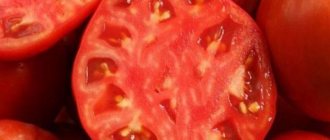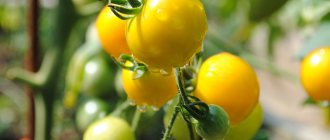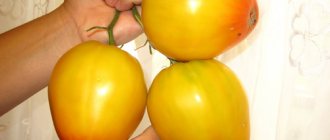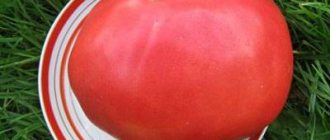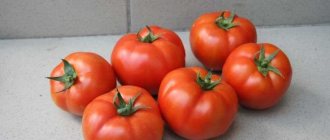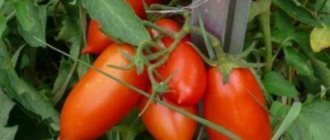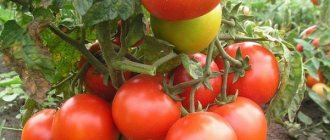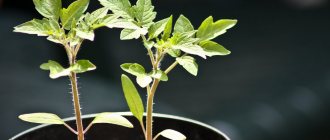The Goldfish tomato variety has been known since 1999. Originator – agro. It was created for cultivation on private farms; seasonal greenhouses, greenhouses, and open ground in the southern regions are used for planting.
| Height | Landing location | Ripening time | Fruit color | Fruit size | Origin | Fruit shape |
| Tall | Greenhouse, Open ground | Mid-season | Yellow | Average | Variety | With spout |
Description and characteristics of the variety
The indeterminate type plant grows up to 2 meters, and even higher in greenhouses. Average ripening time is 115-120 days. Fruiting is extended and ends with the onset of cold weather. The bush is massive and produces shoots abundantly. The leaves are carved, long, drooping, light green in color. Goldfish tomatoes ripen quite late, so in central regions the plants are planted in greenhouses.
The bush is formed into 2-3 stems, each shoot is completed after 4 brushes are formed on it.
The first inflorescence appears after 8-9 leaves, subsequent ones - after 3 leaves. The brush is intermediate, branched, the stalks are long. The weight of a tomato is 80-120 grams, up to 10 pieces per brush. The fruits are cylindrical, elongated, with a small nose. The skin is thin, color from bright yellow to yellow-orange. The pulp is dense, contains 2 seed chambers, there are a lot of seeds, the tomatoes are juicy.
Planting and caring for crops
The optimal way to grow Goldfish tomatoes is by seedling method. Seeds can be purchased or prepared yourself. Subject to storage conditions (without sudden changes in temperature, humidity, preferably in a glass container with a tight-fitting lid), they retain their properties for at least five years.
Preparation of soil and planting material
In order for the seeds to germinate together and produce strong and healthy seedlings, you need to do some work with them before planting:
- culling - immerse the seeds in a solution of 1 teaspoon of salt in a glass of water, stir for 2-3 minutes, and let stand. Those that have settled to the bottom are washed with clean water, dried and used, those that float are removed;
- disinfection - selected seeds are immersed for 15-20 minutes in a 1% solution of potassium permanganate or for 5-10 minutes in a 2-3% solution of hydrogen peroxide, heated to 40°C;
- stimulation - soak for a day in such industrial solutions as "Epin", "Immunocytofit", potassium or sodium humates, or in home remedies - potato juice or aloe. After treatment, no rinsing is necessary.
It is better to plant pre-sprouted seeds. To do this, they are laid out on filter paper or gauze in a saucer and care is taken that this material does not dry out. A day is usually enough for germination.
Soil for tomato seedlings Goldfish can be purchased ready-made universal or mixed equal parts peat and sand, sifted, roasted for disinfection in the oven or poured with a solution of potassium permanganate. In any convenient way, it is advisable to disinfect the container for seedlings.
Time and sowing patterns
It takes about two months to force seedlings, and they are transferred to open ground when the threat of frost has completely passed. Since Goldfish tomatoes are grown without shelter only in the south of Russia, sowing is approximately carried out there in the third decade of February and the first half of March. Then the seedlings can be transferred to the beds, starting from the second half of April until the 20th of May.
In other regions, it is recommended to plant Goldfish seedlings in film shelters, so you can move the start of sowing work a couple of weeks earlier. Thus, to grow this variety in greenhouses, seeds are sown:
- in central Russia - from the beginning of March for two weeks (with planting in greenhouse beds from the end of April to the second half of May);
- in the northern regions, in the Urals, in Siberia - in the second half of March (respectively, landing - from the second half of May until the end of this month).
Make holes 1.5-2 cm deep in a slightly moistened soil substrate, place seeds in them and sprinkle the same soil on top without compaction. Cover with glass or film to create greenhouse conditions, and artificially increase daylight hours to 10-12 hours.
After 1-2 true leaves appear, pickling is done - planting young tomatoes in separate containers while simultaneously pinching the tip of the root a couple of millimeters for better branching.
Transplanting seedlings into open ground
By the time of transfer to the beds, the plants should have time to form 5-7 true leaves. It is optimal to plant tomato seedlings at a distance of 50-60 cm from each other, maintaining a distance of a meter between rows. If greenhouse conditions allow, then plants are planted in the middle row in a checkerboard pattern with two strips, leaving passages on both sides. One square meter is enough to accommodate three plants.
The best soil for any tomatoes is loamy, sufficiently fertilized. All work on cultivating the land is carried out in the fall, and in the spring they only loosen and disinfect the soil, spilling it a week before the intended planting of seedlings with a hot solution of copper sulfate.
See also Sweet Cherry tomatoes f1: characteristics and growing features
Half-rotted humus is added to the holes. If the seedlings of young tomatoes have become very elongated, they are placed in a hole “reclining”, while at the same time covering part of the stem with soil. After planting, mulch with a mixture of rotted manure and sawdust or leaves.
Watering mode
Watering of Goldfish tomatoes is carried out as needed. On average, in the heat of summer in a greenhouse - once a week or ten days, in open ground - more often, depending on the condition of the plants.
After watering, loosen the soil and add moist soil to the stems to form additional roots.
How to feed bushes
Goldfish tomatoes are fed like any tomato plants three times a season:
- two weeks after planting in the ground - a solution of bird droppings or mullein (700 g per bucket of water), ready-made preparations "Vermistil" or "Humaisol" are also suitable;
- after the flowers appear on the second brush, use a solution of a glass of superphosphate in a bucket of water;
- after the first fruits begin to ripen, use complex fertilizer in an amount of 50-100 g per 10 liters of water.
When feeding, pour at least 2 liters of nutrient solution under the bush.
Forming and tying
To get tomatoes as large as possible, the indeterminate variety Zolotaya Rybka is formed into one stem: after planting the seedlings, all the stepsons are removed, breaking them out in the leaf axils. The crop is fully formed on the central stem.
Expert opinion
Stanislav Pavlovich
Gardener with 17 years of experience and our expert
Ask a Question
Pinching is a constant procedure; it is carried out at least every three days, preventing strong shoot regrowth. Also, old, yellowed leaf blades are removed in a timely manner.
Preventative treatments
To prevent the development of fungal infections of tomatoes, preventive spraying of sprouts with Fitosporin, Baksis, Ecosil and others is carried out:
- the first treatment is carried out a week before the seedlings are moved to permanent beds;
- the second - a week after landing;
- the third - before the bushes bloom;
- the last one - after the end of flowering.
The most important measure to prevent the development of any diseases is to maintain tomato crop rotation.
Features of cultivation and storage
Tall tomatoes are characterized by vertical development of the root system, so they do not need frequent watering. The roots go deeper than those of determinate varieties, receiving nutrition and moisture from the lower layers of the soil. If you carry out foliar feeding with boric acid, the number of fruits will increase.
The largest ripe tomatoes are left for seeds.
The variety is mid-season, but the last tomatoes are picked unripe. They are stored at home and ripen quickly when exposed to light. Healthy whole specimens at technical ripeness are selected for storage in the cellar. When ripened tomatoes are in storage, they emit ethylene, which promotes the ripening of other tomatoes and reduces shelf life.
Main characteristics
The Goldfish tomato is resistant to adverse weather conditions; fruiting continues even when the temperature drops or during the rainy season.
Review of the “Goldfish” tomato variety and about blossom end rot on tomatoes - video
Productivity
From the bushes of the Golden Fish tomato variety, a large number of fruits are collected, which form gradually and ripen also gradually. During the season, with good care, about 8 kg of beautiful and tasty tomatoes are harvested from each bush.
Area of application of fruits
The ripe fruits of the Goldfish tomato look beautiful in salads and can be used to decorate dishes and prepare various snacks. The taste of the Goldfish tomato fruit is pleasant and sweet, so they are eaten fresh with pleasure.
Varieties of oblong tomatoes:
Tomato Gulliver Tomato Gigolo Tomatoes Royal temptation F1
Elongated tomatoes are well suited for whole-fruit canning; they do not crack or spread during heat treatment.
Advantages and disadvantages
There are no ideal varieties; each tomato has its own advantages and disadvantages. The Goldfish has quite a lot of positive aspects, but there are practically no disadvantages.
Pros of tomato:
- Good yield;
- Excellent taste characteristics;
- Possibility of whole-fruit preservation;
- Yellow color indicates the absence of allergens and high carotene content;
- Withstands long-term transportation;
- Does not crack;
- Resistant to unfavorable climatic conditions, not afraid of frost;
- Drought resistant;
- Abundant and long-term fruiting, until October;
- Long shelf life while maintaining the appearance and composition of nutrients;
- Ability to ripen on a removed hand;
- High content of tetra-cis-lycopene - an enzyme responsible for the youth of the skin and the body as a whole.
Note. Tomatoes picked with the stalk last longer.
Cons of tomato:
- Requires pinching, gartering to a support;
- Long growth without ovaries;
- Does not have lasting immunity to diseases.
Goldfish is rich in fiber, vitamins A, C and lycopene, and contains no cholesterol. But, compared to red varieties, this figure is significantly lower.
“Goldfish” combines an exquisite appearance and an unusually sweet taste, and is rightly considered one of the best among yellow tomatoes. The number of shortcomings is minimal, and even then they can be attributed simply to a physiological characteristic. The occurrence of diseases can be prevented by appropriate care, in which the tomato is not capricious, the main conditions are good soil and timely watering.
https://repka.online/ovoshhi/tomaty/srednespelyie/zolotaya-ryibka.htmlhttps://wiki-dacha.ru/tomat-zolotaya-rybkahttps://7ogorod.ru/pomidory/tomat-zolotaa-rybka.html
Diseases and pests
This tomato variety has good resistance to many diseases, in particular late blight.
u. But the Goldfish tomato has low resistance to blossom end rot. Therefore, during the period of growing seedlings, it is necessary to feed the plants with complex mineral fertilizer, which necessarily includes calcium.
Useful article:
Iodine for late blight on tomatoes - how to prepare and process
You should also keep the soil in the beds sufficiently moist, for which purpose the root zone of the tomato is mulched with humus or straw.
Advantages
The main advantages of the Goldfish tomato include:
- variety resistance to adverse weather conditions;
- good yield;
- stable fruiting extended over time;
- good dessert taste of ripe Goldfish tomatoes;
- beautiful color of ripe tomatoes;
- The harvested crop tolerates transportation well and has an average shelf life.
Tomato Goldfish - photo on a bush
But the variety also has a number of disadvantages:
- the need to form bushes;
- tall shoots require mandatory garter;
- low resistance of bushes to blossom end rot.
How to grow tomatoes
After 2 months, the seedlings are ready to be transplanted to a permanent location. At this time, the young bushes look stronger, they have at least 7 true leaves and a fully developed root system.
Landing
It is best to plant in open ground in the evening or in cloudy weather, since the tomato does not like direct sunlight and it will be more difficult for it to adapt to new conditions at an unfavorable moment.
The holes are prepared in advance with a depth of 15-25 cm. A little ash is added to the bottom and filled with water. After planting, the soil is compacted and hilled. After this, the sprouts are left unattended for 5 days.
Tomato care Golden nugget
Regular watering is established as soon as young bushes adapt to new conditions. Always water with warm, settled water at least 2 times a week. On dry days, the number of waterings is increased to 3 times a week.
Water at the root, without getting on the leaves, to avoid burning the green mass. The best irrigation option is drip irrigation. To do this, place an ordinary plastic bottle without a bottom next to the roots of the plant. Water is poured into it, and the moisture gradually penetrates to the roots. After each watering, the soil is loosened and hilled up.
Mulching the beds with straw or peat retains moisture in the beds, making watering less frequent. Mulching is also a preventive measure in pest control.
Feed at least 3 times per season with a complex of mineral fertilizers or organic matter. Mullein infusion and bird droppings in a concentration of 1:15 with water are suitable as organic matter.
The first feeding is carried out 2 weeks after transplanting the seedlings. Plants require a second feeding during flowering, and a third feeding during fruit formation.
Features of cultivation and possible difficulties
Tall bushes of the Golden Nugget require mandatory pinching. They are tied to a wooden support or to metal rods, which are installed immediately when planting the bushes in the ground. Many gardeners install trellises, which is considered the most convenient way to garter.
Since the plant is characterized by a constant increase in green mass, there is a need for systematic pinching. Remove unnecessary shoots in the morning. After the procedure, the bushes are treated with a weak solution of potassium permanganate.
The highest fruiting rate of this variety is when growing a bush with 2 stems.
Diseases and pests
The species is resistant to Fusarium wilt, tomato bronzing, gray spot, verticillium and tobacco mosaic. But late blight is susceptible to fungal disease. Mandatory preventive measures will help prevent the spread of pathogenic spores. To do this, you need to systematically loosen the beds and remove weeds with roots.
Waterlogging of the soil and elevated air temperatures are favorable factors for the development of fungal infections. Therefore, it is necessary to control the soil moisture level. The lower leaves are removed so that they do not rot from constant contact with wet beds, which also contributes to the spread of the fungus.
If the disease does affect the crop, fungicides, for example, Fitosporin, will help in the fight against it. Copper sulfate, which is sprayed on both the soil and plants, also helps a lot. Copper sulfate is also used as a preventive measure.
Among the pests, beware of the mole cricket and the Colorado potato beetle. The mole cricket moves underground, disturbing the root system. It is almost impossible to notice it, but strong-smelling herbs such as calendula and marigolds, planted next to the tomatoes, help scare it away from the garden beds.
Spraying the bushes with mustard powder can help prevent the Colorado potato beetle. The beetle itself and its larvae are collected by hand and burned. Regular inspection of bushes helps to protect plants from insect invasion in time.
Sowing seedlings
Sowing of seedlings begins in March.
Soil preparation
For seedlings, prepare plastic boxes of a suitable size and loose nutrient soil.
The soil is made up of equal parts:
- well-rotted turf soil,
- humus,
- clean river sand.
For sowing, you can also use universal industrial soil based on peat.
Seeds can be sown with or without germination:
- In the first case, the seed material is pickled in a pink solution of potassium permanganate, then sowing is started immediately.
- In the second, after dressing, the seeds are laid out on a damp piece of cloth or napkin. After pecking, they are immediately sown in the ground.
With a small number of seedlings, it is convenient to use peat tablets for sowing. Their use will avoid labor-intensive picking. Before use, the tablets are soaked in warm water until completely swollen. One seed is sown in each tablet.

